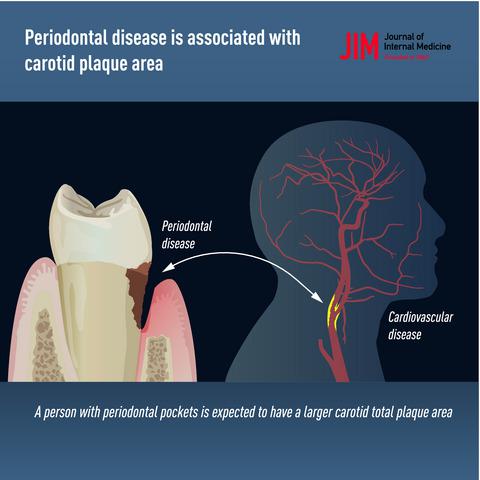当前位置:
X-MOL 学术
›
J. Intern. Med.
›
论文详情
Our official English website, www.x-mol.net, welcomes your
feedback! (Note: you will need to create a separate account there.)
Periodontal disease is associated with carotid plaque area: the Malmö Offspring Dental Study (MODS).
Journal of Internal Medicine ( IF 9.0 ) Pub Date : 2019-11-13 , DOI: 10.1111/joim.12998 D Jönsson 1, 2 , M Orho-Melander 3 , R T Demmer 4, 5 , G Engström 3 , O Melander 3 , B Klinge 1, 6 , P M Nilsson 3
Journal of Internal Medicine ( IF 9.0 ) Pub Date : 2019-11-13 , DOI: 10.1111/joim.12998 D Jönsson 1, 2 , M Orho-Melander 3 , R T Demmer 4, 5 , G Engström 3 , O Melander 3 , B Klinge 1, 6 , P M Nilsson 3
Affiliation

|
BACKGROUND
Periodontal disease is associated with cardiovascular disease (CVD) but it is unknown if periodontal disease severity is associated with asymptomatic carotid plaque. The aim of the current population-based, observational study was to investigate if signs of periodontal disease are associated with the occurrence of carotid plaque and total plaque area (TPA).
METHODS
The Malmö Offspring Study (MOS) is a population-based study. MOS participants underwent a thorough cardiovascular phenotyping, including carotid ultrasonography. The Malmö Offspring Dental Study (MODS) invited participants of MOS for dental examination, including periodontal charting. Multivariable regression models were used to analyse the presence of carotid plaque and TPA in relation to periodontal parameters.
RESULTS
In all, 831 MODS participants were recruited, out of which 495 belonged to the children generation with mean age of 53 years, 63% had carotid plaque and 38% had moderate or severe periodontal disease. In models adjusted for CVD risk factors, the OR for having carotid plaque in subjects with vs without periodontal disease was 1.75 (95% CI: 1.11-2.78). In a linear model with TPA as dependent and number of periodontal pockets ≥ 4 mm as independent variable, the adjusted beta-coefficient was 0.34 mm2 (95% CI 0.16-0.52).
CONCLUSION
Individuals within the highest quartile of periodontal pockets are expected to have 9 mm2 larger TPA compared to those without pockets. Our results suggest that intervention studies addressing periodontal disease could be useful for prevention of CVD.
中文翻译:

牙周病与颈动脉斑块面积有关:马尔默后代牙齿研究(MODS)。
背景技术牙周疾病与心血管疾病(CVD)有关,但是尚不清楚牙周疾病的严重程度是否与无症状的颈动脉斑块有关。当前基于人群的观察性研究的目的是调查牙周疾病的体征是否与颈动脉斑块和总斑块面积(TPA)的发生有关。方法马尔默后代研究(MOS)是一项基于人群的研究。MOS参与者进行了彻底的心血管表型检查,包括颈动脉超声检查。马尔默后代牙科研究(MODS)邀请MOS的参与者进行牙科检查,包括牙周图表检查。多变量回归模型用于分析与牙周参数相关的颈动脉斑块和TPA的存在。结果总共招募了831位MODS参与者,其中495个属于平均年龄为53岁的儿童,其中63%患有颈动脉斑块,38%患有中度或重度牙周疾病。在针对CVD危险因素进行调整的模型中,患有或未患有牙周疾病的受试者中颈动脉斑块的OR为1.75(95%CI:1.11-2.78)。在以TPA为因数且牙周袋数目≥4 mm作为自变量的线性模型中,调整后的β系数为0.34 mm2(95%CI 0.16-0.52)。结论牙周袋最高四分位数内的人与没有袋的人相比,TPA预计要大9 mm2。我们的结果表明,针对牙周疾病的干预研究可能有助于预防CVD。63%的患者患有颈动脉斑块,而38%的患者患有中度或严重的牙周疾病。在针对CVD危险因素进行调整的模型中,患有或未患有牙周疾病的受试者中颈动脉斑块的OR为1.75(95%CI:1.11-2.78)。在以TPA为因数且牙周袋数目≥4 mm作为自变量的线性模型中,调整后的β系数为0.34 mm2(95%CI 0.16-0.52)。结论牙周袋最高四分位数内的人与没有袋的人相比,TPA预计要大9 mm2。我们的结果表明,针对牙周疾病的干预研究可能有助于预防CVD。63%的患者患有颈动脉斑块,而38%的患者患有中度或严重的牙周疾病。在针对CVD危险因素进行调整的模型中,患有或未患有牙周疾病的受试者的颈动脉斑块的OR为1.75(95%CI:1.11-2.78)。在以TPA为因数且牙周袋数目≥4 mm作为自变量的线性模型中,调整后的β系数为0.34 mm2(95%CI 0.16-0.52)。结论牙周袋最高四分位数内的人与没有袋的人相比,TPA预计要大9 mm2。我们的结果表明,针对牙周疾病的干预研究可能有助于预防CVD。在以TPA为因数且牙周袋数目≥4 mm作为自变量的线性模型中,调整后的β系数为0.34 mm2(95%CI 0.16-0.52)。结论牙周袋最高四分位数内的人与没有袋的人相比,TPA预计要大9 mm2。我们的结果表明,针对牙周疾病的干预研究可能有助于预防CVD。在以TPA为因数且牙周袋数目≥4 mm作为自变量的线性模型中,调整后的β系数为0.34 mm2(95%CI 0.16-0.52)。结论牙周袋最高四分位数内的人与没有袋的人相比,TPA预计要大9 mm2。我们的结果表明,针对牙周疾病的干预研究可能有助于预防CVD。
更新日期:2019-11-14
中文翻译:

牙周病与颈动脉斑块面积有关:马尔默后代牙齿研究(MODS)。
背景技术牙周疾病与心血管疾病(CVD)有关,但是尚不清楚牙周疾病的严重程度是否与无症状的颈动脉斑块有关。当前基于人群的观察性研究的目的是调查牙周疾病的体征是否与颈动脉斑块和总斑块面积(TPA)的发生有关。方法马尔默后代研究(MOS)是一项基于人群的研究。MOS参与者进行了彻底的心血管表型检查,包括颈动脉超声检查。马尔默后代牙科研究(MODS)邀请MOS的参与者进行牙科检查,包括牙周图表检查。多变量回归模型用于分析与牙周参数相关的颈动脉斑块和TPA的存在。结果总共招募了831位MODS参与者,其中495个属于平均年龄为53岁的儿童,其中63%患有颈动脉斑块,38%患有中度或重度牙周疾病。在针对CVD危险因素进行调整的模型中,患有或未患有牙周疾病的受试者中颈动脉斑块的OR为1.75(95%CI:1.11-2.78)。在以TPA为因数且牙周袋数目≥4 mm作为自变量的线性模型中,调整后的β系数为0.34 mm2(95%CI 0.16-0.52)。结论牙周袋最高四分位数内的人与没有袋的人相比,TPA预计要大9 mm2。我们的结果表明,针对牙周疾病的干预研究可能有助于预防CVD。63%的患者患有颈动脉斑块,而38%的患者患有中度或严重的牙周疾病。在针对CVD危险因素进行调整的模型中,患有或未患有牙周疾病的受试者中颈动脉斑块的OR为1.75(95%CI:1.11-2.78)。在以TPA为因数且牙周袋数目≥4 mm作为自变量的线性模型中,调整后的β系数为0.34 mm2(95%CI 0.16-0.52)。结论牙周袋最高四分位数内的人与没有袋的人相比,TPA预计要大9 mm2。我们的结果表明,针对牙周疾病的干预研究可能有助于预防CVD。63%的患者患有颈动脉斑块,而38%的患者患有中度或严重的牙周疾病。在针对CVD危险因素进行调整的模型中,患有或未患有牙周疾病的受试者的颈动脉斑块的OR为1.75(95%CI:1.11-2.78)。在以TPA为因数且牙周袋数目≥4 mm作为自变量的线性模型中,调整后的β系数为0.34 mm2(95%CI 0.16-0.52)。结论牙周袋最高四分位数内的人与没有袋的人相比,TPA预计要大9 mm2。我们的结果表明,针对牙周疾病的干预研究可能有助于预防CVD。在以TPA为因数且牙周袋数目≥4 mm作为自变量的线性模型中,调整后的β系数为0.34 mm2(95%CI 0.16-0.52)。结论牙周袋最高四分位数内的人与没有袋的人相比,TPA预计要大9 mm2。我们的结果表明,针对牙周疾病的干预研究可能有助于预防CVD。在以TPA为因数且牙周袋数目≥4 mm作为自变量的线性模型中,调整后的β系数为0.34 mm2(95%CI 0.16-0.52)。结论牙周袋最高四分位数内的人与没有袋的人相比,TPA预计要大9 mm2。我们的结果表明,针对牙周疾病的干预研究可能有助于预防CVD。







































 京公网安备 11010802027423号
京公网安备 11010802027423号